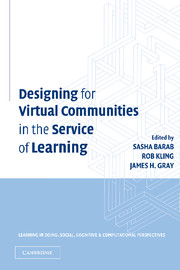Book contents
- Frontmatter
- Contents
- List of Contributors
- Series Foreword
- Foreword
- Preface and Acknowledgments
- In Memoriam
- PART I COMING TO TERMS WITH COMMUNITY
- 1 Introduction
- 2 Online Learning Communities
- PART II DESIGNING FOR WEB-SUPPORTED COMMUNITY
- PART III FOSTERING COMMUNITY/MEMBER PARTICIPATION
- PART IV RESEARCHING ONLINE COMMUNITY
- Index
- Titles in the series
- References
1 - Introduction
Designing for Virtual Communities in the Service of Learning
Published online by Cambridge University Press: 05 June 2012
- Frontmatter
- Contents
- List of Contributors
- Series Foreword
- Foreword
- Preface and Acknowledgments
- In Memoriam
- PART I COMING TO TERMS WITH COMMUNITY
- 1 Introduction
- 2 Online Learning Communities
- PART II DESIGNING FOR WEB-SUPPORTED COMMUNITY
- PART III FOSTERING COMMUNITY/MEMBER PARTICIPATION
- PART IV RESEARCHING ONLINE COMMUNITY
- Index
- Titles in the series
- References
Summary
Currently, numerous educators and policy makers are advocating a move away from teacher-centered models of instruction and toward more learner-centered and community-based models. However, at present the word “community” is at risk of losing its meaning. We have little appreciation and few criteria for distinguishing between a community of learners and a group of students learning collaboratively (Barab & Duffy, 2000; Grossman, Wineburg, & Woolworth, 2000; Wineburg & Grossman, 1998). Given the proliferation of terms such as communities of learners, discourse communities, learning communities, knowledge-building communities, school communities, and communities of practice, it is clear that
community has become an obligatory appendage to every educational innovation. Yet aside from linguistic kinship, it is not clear what features, if any, are shared across terms. This confusion is most pronounced in the ubiquitous “virtual community,” where, by paying a fee or typing a password, anyone who visits a web site automatically becomes a “member” of the community … Groups of people become community, or so it would seem, by the flourish of a researcher's pen.
(Grossman, Wineburg, & Woolworth, 2000, p. 2, italics in original)Too little of the education literature provides clear criteria for what does and does not constitute community; the term is too often employed as a slogan rather than as an analytical category. We also know little about the educational value of employing a community model for supporting learning.
Information
- Type
- Chapter
- Information
- Publisher: Cambridge University PressPrint publication year: 2004
References
Accessibility standard: Unknown
Why this information is here
This section outlines the accessibility features of this content - including support for screen readers, full keyboard navigation and high-contrast display options. This may not be relevant for you.Accessibility Information
- 20
- Cited by
